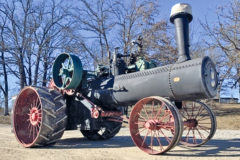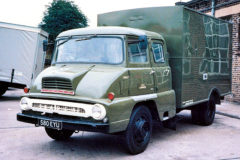Fantastic Ford Force 4000!
Posted by Chris Graham on 22nd July 2021
The fantastic Ford Force 4000 was a top-selling tractor in the late 1960s and can represent a great first tractor for new buyers today.

Fantastic Ford Force 4000: This tractor was one of an initially four-model range that succeeded the ‘pre-Force’, 1000 Series models in 1968, and was a tremendous sales success for Ford.
Buying a tractor is always an exciting thing to do, doubly so if it’s your first one. But there are several important, practical considerations that the wise buyer should always bear in mind. It’s all too easy to get carried away in the process, to get ‘blinded’ by your excitement and desire to buy, and to forget about the basics as you get thoroughly caught up in the prospect of all that fun you’re going to have with your new machine.
However, as with buying anything expensive, the best purchases are made by those who remain able to keep their feet on the ground, and their enthusiasm in check. The practicalities of what you’re about to do should stay uppermost in your mind, and you need to be sure about why you want the tractor, where you’re going to keep it, how you’re going to look after it and what you’re going to do with it.
Which model?
Choosing the right model is obviously important, at many levels. If you’re a ‘practical’ person, then an older machine that’ll require higher levels of maintenance and mechanical input might be a good fit. But, if you’re new to the old tractor scene and have limited workshop skills, then something newer – that’ll hopefully be more reliable and easier to live with – could well be the smarter option.
Size always matters, too! ‘Beginners’ are best advised to pick a model from the smaller end of the scale, simply because it’ll be easier to handle, more convenient to garage and not such a daunting prospect to transport around. Don’t forget that, if you have visions of parading your tractor in the show ring, attending ‘working days’ or sampling the strangely addictive pleasures of competition ploughing, then you’ll need to trailer the machine safely to and from events.
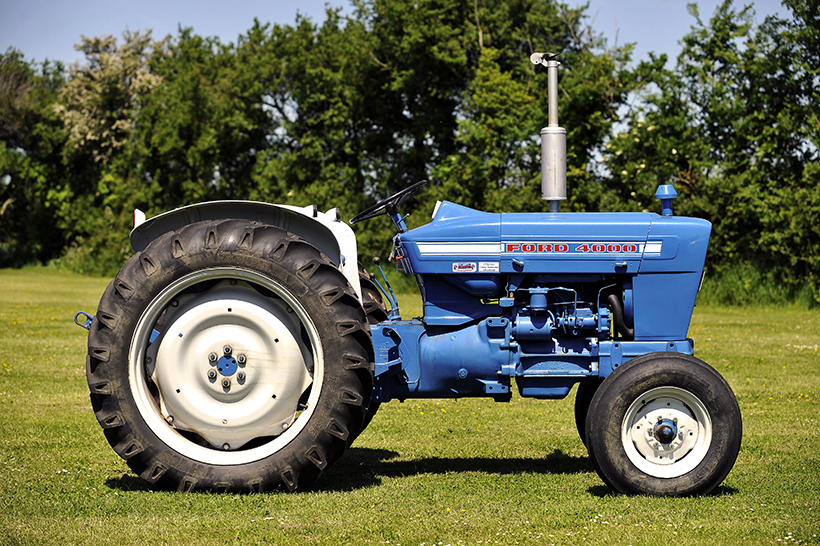
The ‘cleaner’ bonnet sides, revised front grille and new decals are what most obviously set the Force models apart from their predecessors.
Doing this with anything weighing more than around two tonnes is likely to take you beyond decent 4×4 territory, and into the area of lorry-based transportation. So, unless you have access to such machinery yourself, think carefully before you hand over any cash for any machine that’s vaguely heavyweight.
With all this in mind, our subject here could very well be the pick of the bunch for the would-be, first-time classic tractor buyer looking for a machine that ticks the majority of those all-important practicality boxes. The Ford Force 4000 was a best-seller in its day and, arguable, the star of Ford’s influential and very successful 1000 Series range.
A turning point
The mid-1960s saw Ford at something of a turning point, regarding its tractor model range. The market was clamouring for more power, and the company was also conscious that its dependable but still popular Dexta and Major models were getting decidedly long in the tooth. Something fresh and modern-looking was required to breathe new life into the ageing line-up, and a model range that could be standardised around the world would simplify things enormously, too.
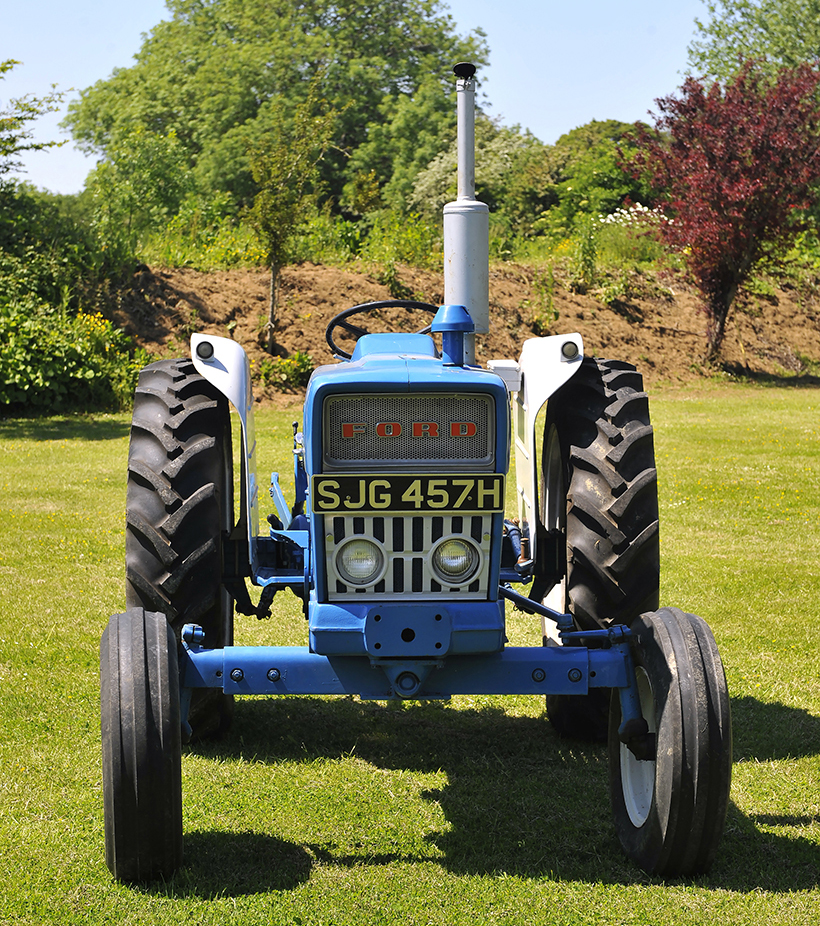
Much of the Ford 4000’s desirability today lies in its appealing combination of manageable size, effective power-to-weight ratio and all-round usefulness.
So it was that, in 1964, Ford announced the four-model 1000 Series range of tractors. Code-named ‘6X’, the new machines were built at Ford’s brand new factory at Basildon, in Essex, as well as in existing plants at Antwerp, Belgium, and Michigan in the USA. The new models – branded for the first time as ‘Ford’ tractors – replaced the existing Fordson machines here in the UK although, in a bid to keep help smooth the transition to a new, number-based model designation system, and help keep existing customers on-side, it was decided to continue using some of the traditional model names for the new machines.
The four new models were the 37hp 2000 Dexta, the 46hp Super Dexta 3000, the 55hp 4000 Major and the range-topping, 65hp, 5000 Super Major. The latter was launched with a four-cylinder diesel engine, but all the rest were powered by three-cylinder motors. The shiny new models with their sharp, clean-cut lines, caused quite a stir at the 1964 Smithfield Show, and certainly looked a good deal more modern than their predecessors.
Select-O-Speed
Ford also introduced the unsuspecting UK to the 10-speed, powershift, Select-O-Speed transmission, which was made available as an optional alternative to the standard, six- or eight-speed manual transmission. Unfortunately, good though the new models looked, the on-farm performance proved to be less impressive when the first 1000 Series machines started hitting the fields during 1965. All sorts of niggling problems afflicted the new tractors and, almost from day one, Ford found itself fighting a PR nightmare as word spread about unreliability, and warranty claims ballooned.
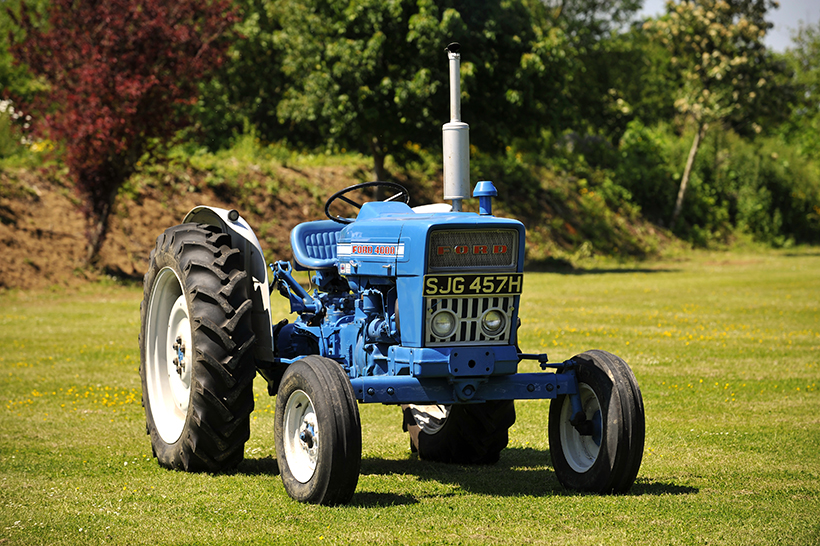
Production of the Force 4000 – as with the other 2000, 3000, 5000 and 7000 models – ran between 1968 and 1975.
But the company battled manfully on through the problems, all the while remaining confident about the fundamental value of its new models; a fighting spirit which, ultimately, proved completely justified. The 5000 quickly became popular with established conversion specialists like County, Roadless and Doe, and this did much to enhance the model’s reputation.
Then, in 1968, Ford pulled another rabbit from the hat, with the introduction of the Force range of tractors. Designated ‘6Y’ at the factory, these replaced the four, 1000 Series machines like-for-like, offered even cleaner bodywork styling and a host of worthwhile, engineering and performance improvements. The 2000 and 3000 models changed the least, only benefitting from minor improvements to the hydraulic systems, the PTO and the transmission, as well as the exterior design changes, too, of course.
More power
But the 4000 and 5000 also got significant engine upgrades, which boosted maximum power outputs to 62 and 75hp, respectively. All four models hit the ground running, in reliability terms, and sales were impressive. But the demand for more power continued to grow, and Ford answered in 1971 with the final significant model in the UK 1000 Series story, the 7000. This 94hp machine was the first British-built tractor to be powered by a turbocharged, four-cylinder diesel engine, but that’s another story!
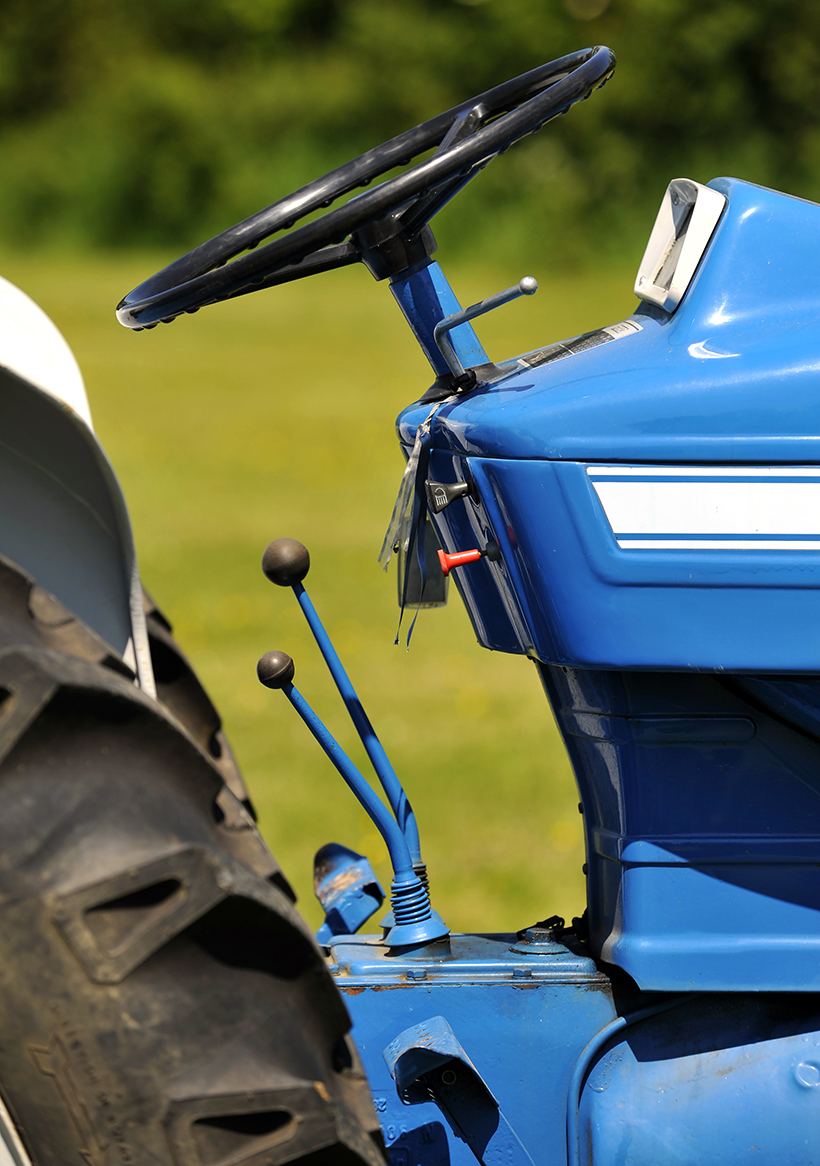
Controls are simple and easy to use. Check for excessive play in the steering and gear selector levers.
Fast-forward 50 years and we find ourselves in a world where the Ford Force 4000 – along with the other 1000 Series models – has become a desirable, collector’s tractor. There’s good demand for these machines and values are slowly climbing but, as things stand, prices remain relatively affordable, which is good news. Unfortunately, the stock of machines that would-be buyers now have to choose from, can be something of a mixed bag.
As tractor power outputs increase progressively during the 1970s and ’80s, so ageing models like the Force 4000 became marginalised on many farms. Ultimately, the sad fate for many was to end up as the neglected yard scraper, struggling on in the face of minimal maintenance and next to no TLC. Against such a backdrop, the condition of many examples deteriorated quite quickly, with panel corrosion, hydraulic problems and wear and tear leaving many examples in a sorry state.
It’s a sad but all too common story which Ford tractor enthusiasts like John Vowell are all too well aware of. John has been a Ford Force 4000 owner for the past 16 years, and found his model in just such a state back in 2005. But, having fully restored it to the fine condition we see today, he’s ideally placed to give experienced-based advice about buying and owning the 4000.
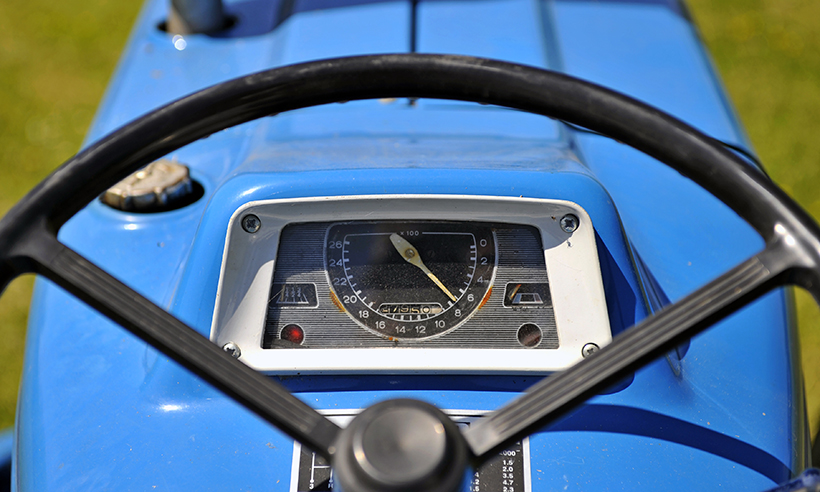
A straightforward, all-in-one instrument cluster was a modern feature in its day.
Buying advice
The first point John made, as we chatted on a gloriously sunny and warm June afternoon in rural Kent, was that potential buyers should always find out as much as possible about the tractor’s history. “Where a tractor has come from, and what it spent most of its working life doing, are key points to be aware of when deciding about a purchase,” he explained. “As with any old tractor – especially one that’s coming to you as a runner – it’s very valuable to know how it’s been used.
“If it’s come straight from the yard on a dairy farm, then corrosion in the panel work and wheel rims is likely to be a real problem. Genuine, good-condition replacements are getting increasingly difficult to source nowadays and, while pattern parts are available, these just aren’t the same as having the real thing, in my view.
“I know of three dairy farms that are still using Ford 4000s as yard-scrapers today, and even a 5000 that spends its days powering a slurry pump. So, I’m sure there are still a good number of these models out there, working for their livings. Inevitably, though, this sort of menial use takes its toll and buying any tractor fresh out of that sort of environment is likely to present a challenge. So, it’s important to know what you might be letting yourself in for.”

The Force models enjoyed enhanced hydraulics, compared to their predecessors. System reliability is generally good, assuming it’s been properly maintained and escaped abuse.
John then went on to explain that engine condition is another very important aspect to assess. “The 4000’s three-cylinder diesel engine, while an essentially good and reliable unit, was dogged by the now-famous porous block problems that affected so many Ford motors from this period. This went on until Ford introduced the later engine block, with the revised casting (identified by an external, criss-cross pattern).”
Coolant leakage
“Engines suffering in this way allow the coolant solution to find its way into the engine oil, leading to both engine overheating and inefficient lubrication. Left unchecked, engine seizure is likely to be the outcome. The fitting of cylinder liners was one solution but, of course, it’s not possible to see whether this has been done without stripping the engine.
“In some cases, a previous owner may be aware that such work was carried out in the past but, if not, then it’s important to be aware of the potential for this trouble, and to be prepared for the expenditure involved in sorting it out. Check the oil on the dipstick and inside the filler cap, for tell-tale signs of emulsification; if you find a creamy, mayonnaise-like mess, then expect the worst.” On the other hand, if the oil looks completely clean then, unless the tractor is being extremely well maintained, it’s possible that the owner may have flushed the system and refilled it with new oil, just to disguise the problem and promote the sale. Always be on your guard!
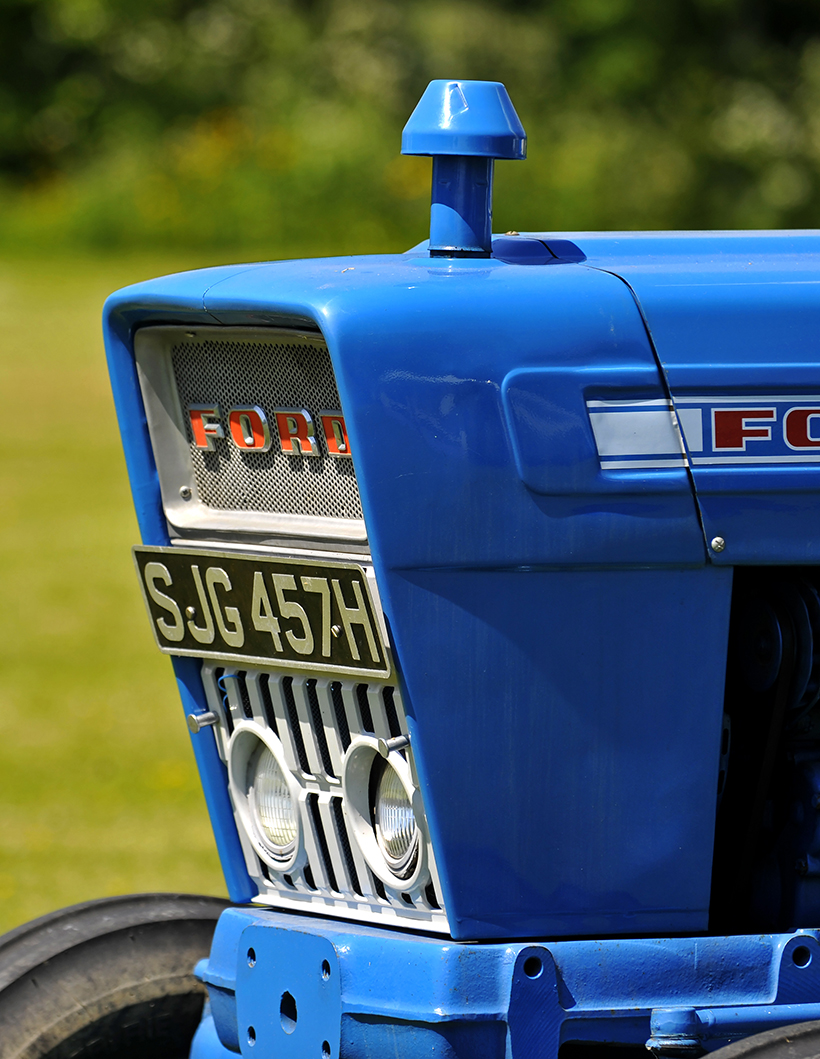
The front grille design on the Force ‘6Y’ models was very different, and a good deal more contemporary, than that found on the ‘6X’ pre-Force variants.
John continued: “Also, if the tractor you’re looking at has been confined to relatively light duties, such as working a saw bench or pump, then it’s likely that the engine will be coked-up and, as a result, will be throwing oil out of the exhaust. Ideally, these engines need to be properly worked to give their best.
“I once sold a 4000 that, although unrestored, was in very good mechanical condition. It went to a woodsman who, two or three weeks after taking delivery, gave me a call to report that the engine was throwing oil out of the exhaust. Naturally, I went to have a look and, when I go there, saw that the tractor was being used to run a wood processor. I asked if it could be disconnected from the machine and, with the new owner’s permission, took it to the bottom of a nearby hill and drove it up, flat out and in top gear. As if by magic, that cleared the engine and all the smoking stopped. So, don’t necessarily be put off a tractor by a badly smoking exhaust.
Smoking issues
“Of course, much depends on the colour of the smoke, and when it’s being produced. A well-maintained engine that’s in good condition may well produce a bit of smoke on initial start-up from cold, but this will soon clear. If the smoke has a blue tinge to it, then this is a sign of minor oil-burning. White smoke indicates unburnt diesel, while black smoke points to excessive burnt diesel.”
Continuing on the ‘engines need to be worked’ theme, John added: “In my experience, the need to work tractor engines applies when they’re being run-in after a rebuild, too. The first thing I did with my 4000, once the restoration was finished (which included a complete engine rebuild), was to hitch up a two-furrow, 14in plough and set it to work ploughing five acres of grassland, in fifth gear. This process took the best part of 10 hours – spread over a day-and-a-half – after which I considered that the engine was effectively run-in. I’m certainly not a believer in a gentle running-in process; just leaving a newly-rebuilt engine to idle, or operate under minimum load, achieves next to nothing, in my view.
“Porosity problems aside, though, this three-cylinder engine is both durable and reliable in the Ford Force 4000 application, which was a major factor in the model’s long-running popularity with farmers. Units that are properly looked after will repay their owners with many years of trouble-free running but, as we all know, engines that have been ‘properly looked after’ are in short supply these days.” Unfortunately, farmers are notorious for cutting corners with both service intervals and the quality of the lubricants and service parts used.
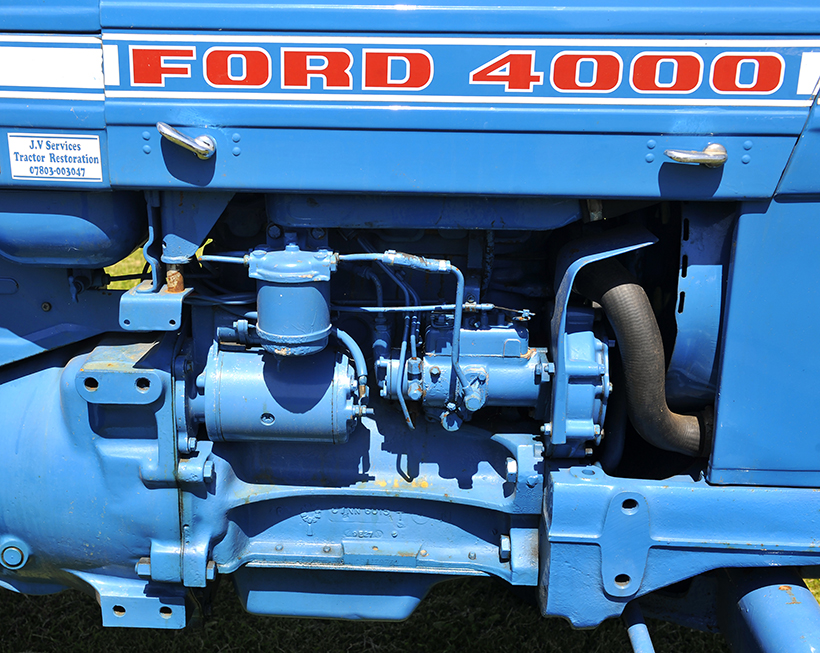
The three-cylinder diesel engine produces a gutsy 62hp in this Force 4000 guise; an output that seemed to suit this model ideally.
John is also a great believer in using only top-quality oils and fuels in his tractors, including the 4000. “I never run my machines on anything other than proper, branded diesel,” he told me. “I want to guarantee that the all-important additive package in the fuel (containing the anti-foaming agents, lubricants, anti-corrosion products, cleaners etc) is as good as it can be. The quality of this certainly suffers in cheaper fuels, which is why I never use them.”
General wear and tear
As I mentioned at the beginning, don’t let the enthusiasm get the better of you when inspecting a prospective purchase; always take your time and don’t be rushed by the seller. Take a note of important wear levels in the steering (wheel and linkages), in the kingpins, wheel bearings and front axle pivots. You must expect varying degrees of this on this age of tractor, unless it’s undergone a thorough and good-quality restoration. Pedal wear is also common and anything too excessive will have to be put right.
You’ll need to drive the tractor to check the gearbox properly (in all gears). Selection should be smooth and easy, without too much play in the main selector lever. The optional Select-O-Speed was never a big seller; it was an expensive extra to buy and, what’s more, soon developed a reputation for being difficult to live with. Mockingly dubbed ‘Jerk-O-Matic’ some of the less charitable wags at the time, low sales numbers mean that 4000s equipped with it now are relatively few and far between. This, in an ironic twist, can make these models more desirable to some.
Finally, John said that there’s little to worry about concerning the Force 4000’s electrics or hydraulics. “The electrical system is simple by modern-day standards, so it’s easy to understand, even for the layman. Serious problems in this department are rare, and the easy-to-follow wiring diagram means that most niggles will be simple to understand and sort out.”
He added: The hydraulic system is pretty robust overall so, assuming decent levels of maintenance and regular use, it’ll serve the tractor well. But lack of use will promote problems. The selector knob on top of the gearbox is a weak point; if its sealing rubber gets damaged or hardens and cracks, then the resultant water ingress will seize the mechanism.”
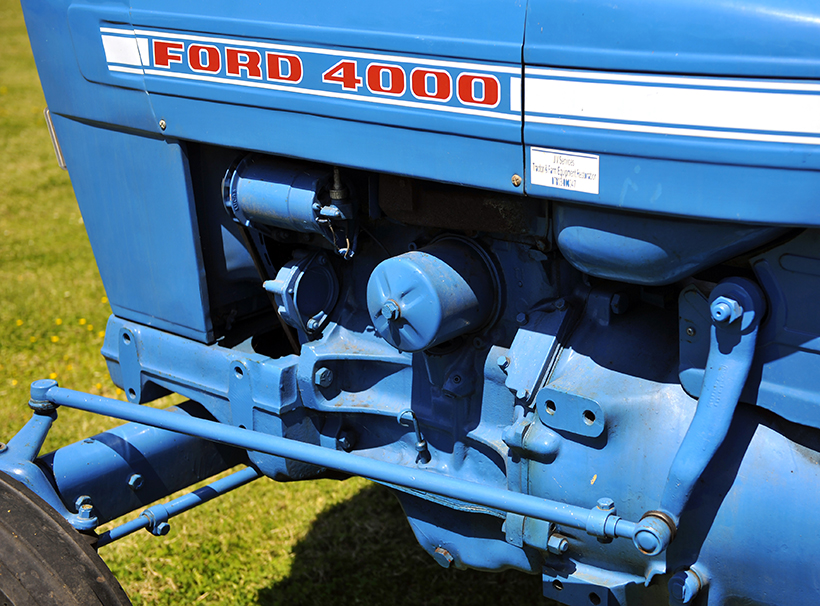
Always check the steering linkages, plus the kingpins and front axle pivots, for signs of wear when buying. Play found in these joints can be a useful price negotiation tool.
Overall, one of the beauties of the Ford Force 4000 is that all of the problems you’re likely to encounter can be dealt with. The spare parts situation is good for this model, and there are very few components that are unobtainable nowadays. John says that only items such as the crown wheel and pinion from the rear axle, and some of the gearbox internals, are really tricky to locate at the moment, so the prospects for rebuild work are very encouraging.
As always, we’d recommend that you take somebody with some specific, Force 4000 experience with you when going to look at a tractor; their specialist knowledge could save you both money and disappointment. It’s certainly a great time to buy one of these popular models and to discover for yourself the versatility and performance potential offered by the fabulous 4000!
Owner’s view: John Vowell
“My dad was a tractor driver and stockman, so I first got involved with tractors as soon as I was big enough to do so, although I wasn’t allowed to start driving until I was 13. The first tractor I actually drove was a Fordson Major. The farm ran a Ransomes, tractor-drawn bagging combine which was worked by a Fordson Power Major with its live clutch. I used to collect and load the sacks of corn produced by the combine, putting them onto a trailer using a bag handler. I also used the farm’s Super Major to go baling, and loved every minute of it.
“When I left school, the plan had been for me to go and do an apprenticeship at Invicta Tractors, in Canterbury, but that didn’t work at, and so my dad got me in at a local garage to do an apprenticeship there, instead. By coincidence, the garage also ran an agricultural contracting business, and owned a Power Major, a baler and a combine harvester. That all started very well, but then the garage sold off the contracting business, and I was forced to work mostly on cars as a mechanic, which I didn’t enjoy.
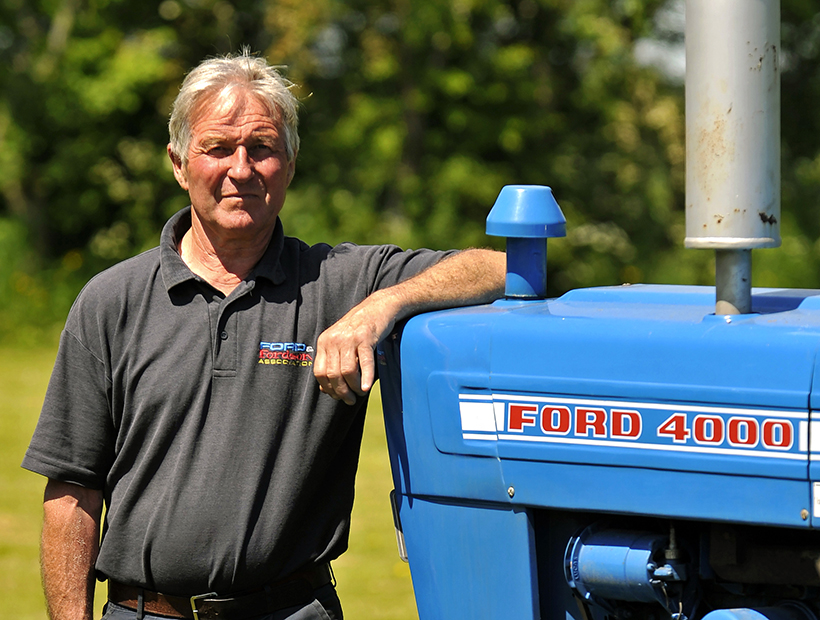
“The first tractor I bought was a Fordson Power Major, which I got in 1968. I did a lot of competition ploughing with that machine – quite successfully – and had a couple of Super Majors, as well. But it wasn’t until 2005 that I came across and bought the 1969 Force 4000. I found it by chance, really, and just fancied doing it up. It required a full restoration, and I was certainly happy to tackle that myself. I really enjoy the whole rebuild process, and get enormous satisfaction from doing things properly.
“I think the Force 4000 is a great little tractor; its size and power output seem perfectly matched, and I just love the sound it makes when it’s working hard. In many respects, I think this 4000 is the sweet spot in the 1000 Series range; everything about it just works so well. It really is a tractor that’s completely fit for purpose!
WHAT TO PAY?
The Ford Force 4000 has been a collectable tractor for a good while now, and yet values remain at affordable levels, which is great news.
At the entry-level, restoration projects are still available for between £1,000 and £2,000 but, for a half-decent running example, you should expect to pay around £3,000. This should get you a fully functioning but unrestored example, but which is likely to need more money spending on it.
At the top of the tree, a fully-restored and professionally finished Ford Force 4000 is likely to set you back a minimum of £6,250.
For a money-saving subscription to Ford & Fordson Tractors magazine, simply click here



